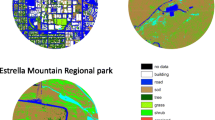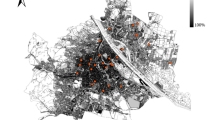Abstract
Birds need to acquire carotenoids for their feather pigmentation from their diet, which means that their plumage color may change as a consequence of human impact on their environment. For example, the carotenoid-based plumage coloration of Great tit, Parus major, nestlings is associated with the degree of environmental pollution. Breast feathers of birds in territories exposed to heavy metals are less yellow than those in unpolluted environments. Here we tested two hypotheses that could explain the observed pattern: (I) deficiency of carotenoids in diet, and (II) pollution-related changes in transfer of carotenoids to feathers. We manipulated dietary carotenoid levels of nestlings and measured the responses in plumage color and tissue concentrations. Our carotenoid supplementation produced the same response in tissue carotenoid concentrations and plumage color in polluted and unpolluted environments. Variation in heavy metal levels did not explain the variation in tissue (yolk, plasma, and feathers) carotenoid concentrations and was not related to plumage coloration. Instead, the variation in plumage yellowness was associated with the availability of carotenoid-rich caterpillars in territories. Our results support the hypothesis that the primary reason for pollution-related variation in plumage color is carotenoid deficiency in the diet.



Similar content being viewed by others
References
Aykin-Burns N, Laegeler A, Kellogg G, Erca N (2003) Oxidative effects of lead in young and adult fisher 344 rats. Archives of Environmental Contamination and Toxicology 44:417–420
Biard C, Surai PF, Møller AP (2005) Effects of carotenoid availability during laying on reproduction in the blue tit. Oecologia 144:32–44
Blount JD (2004) Carotenolds and life-history evolution in animals. Archives of Biochemistry and Biophysics 430:10–15
Blount JD, Houston DC, Møller AP (2000) Why egg yolk is yellow. Trends in Ecology and Evolution 15:47–49
Brush AH (1978) Avian pigmentation. In: Chemical Zoology, Brush AH (editor), New York: Academic Press, pp 141–164
Edge R, McGarvey DJ, Truscott TG (1997) The carotenoids as anti-oxidants—a review. Journal of Photochemistry and Photobiology B: Biology 41:189–200
Eeva T, Lehikoinen E (2000) Improved breeding success in forest passerines after decreased emissions of heavy metals. Nature 403:851–852
Eeva T, Lehikoinen E, Nikinmaa M (2003) Pollution-induced nutritional stress in birds: an experimental study of direct and indirect effects. Ecological Applications 13:1242–1249
Eeva T, Lehikoinen E, Pohjalainen T (1997) Pollution-related variation in food supply and breeding success in two hole-nesting passerines. Ecology 78:1120–1131
Eeva T, Lehikoinen E, Rönkä M (1998) Air pollution fades the plumage of the great tit. Functional Ecology 12:607–612
Eeva T, Ryömä M, Riihimäki J (2005) Pollution-related changes in diets of two insectivorous passerines. Oecologia 145:629–639
Fair J, Whitaker S, Pearson B (2007) Sources of variation in hematocrit in birds. Ibis 149:535–552
Fitze PS, Kölliker M, Richner H (2003a) Effects of common origin and common environment on nestling plumage coloration in the great tit (Parus major). Evolution 57:144–150
Fitze PS, Tschirren B, Richner H (2003b) Carotenoid-based colour expression is determined early in nestling life. Oecologia 137:148–152
Hill GE (2000) Energetic constraints on expression of carotenoid-based plumage coloration. Journal of Avian Biology 31:559–566
Hõrak P, Ots I, Vellau H, Spottiswoode C, Møller AP (2001) Carotenoid-based plumage coloration reflects hemoparasite infection and local survival in breeding great tits. Oecologia 126:166–173
Hõrak P, Surai PF, Møller AP (2002) Fat-soluble antioxidants in the eggs of great tits Parus major in relation to breeding habitat and laying sequence. Avian Science 2:123–130
Isaksson C, McLaughlin P, Monaghan P, Andersson S (2007) Carotenoid pigmentation does not reflect total non-enzymatic antioxidant activity in plasma of adult and nestling great tits, Parus major. Functional Ecology 21:1123–1129
Isaksson C, Örnborg J, Stephensen E, Andersson S (2005) Plasma glutathione and carotenoid coloration as potential biomarkers of environmental stress in great tits. EcoHealth 2:138–146
Johnsen A, Delhey K, Andersson S, Kempenaers B (2003) Plumage colour in nestling blue tits: sexual dichromatism, condition dependence and genetic effects. Proceedings of the Royal Society of London. Series B: Biological Sciences 270:1263–1270
Kiikkilä O (2003) Heavy-metal pollution and remediation of forest soil around the Harjavalta Cu-Ni smelter, in SW Finland. Silva Fennica 37:399–415
Krinsky NI, Yeum KJ (2003) Carotenoid-radical interactions. Biochemical and Biophysical Research Communications 305:754–760
Lessells CM, Boag PT (1987) Unrepeatable repeatabilities: a common mistake. Auk 104:116–121
Mateo R, Hoffman DJ (2001) Differences in oxidative stress between young Canada geese and mallards exposed to lead-contaminated sediment. Journal of Toxicology and Environmental Health—Part A 64:531–545
McGraw KJ (2006) Mechanics of carotenoid-based coloration. In: Bird Coloration I: Mechanisms and Measurements, Hill GE, McGraw KJ (editors), Boston: Harvard University Press, pp 177–242
McGraw KJ, Hill GE, Stradi R, Parker RS (2001) The influence of carotenoid acquisition and utilization on the maintenance of species-typical plumage pigmentation in male American goldfinches (Carduelis tristis) and northern cardinals (Cardinalis cardinalis). Physiological and Biochemical Zoology 74:843–852
Møller AP, Biard C, Blount JD, Houston DC, Ninni P, Saino N et al (2000) Carotenoid-dependent signals: indicators of foraging efficiency, immunocompetence or detoxification ability? Avian and Poultry Biology Reviews 11:137–159
Montgomerie R (2006) Analysing colors. In: Bird Coloration, Hill GE, McGraw KJ (editors), Boston: Harvard University Press, pp 90–147
Partali V, Liaaen-Jensen S, Slagsvold T, Lifjeld JT (1985) Carotenoids in food chain studies—II. The food chain of Parus spp. monitored by carotenoid analysis. Comparative Biochemistry and Physiology B—Comparative Biochemistry and Molecular Biology 82:767–772
Perrins CM (1965) Population fluctuations and clutch-size in the great tit, Parus major L. Journal of Animal Ecology 34:601–647
Polidori MC, Stahl W, Eichler O, Niestroj I, Sies H (2001) Profiles of antioxidants in human plasma. Free Radical Biology and Medicine 30:456–462
Rönkä M (1999) The plumage colour of the great tit (Parus major) nestlings along an air pollution gradient. MSc Thesis, University of Turku, Finland
Royle NJ, Surai PF, McCartney RJ, Speake BK (1999) Parental investment and egg yolk lipid composition in gulls. Functional Ecology 13:298–306
Senar JC, Figuerola J, Domenech J (2003) Plumage coloration and nutritional condition in the great tit Parus major: the roles of carotenoids and melanins differ. Naturwissenschaften 90:234–237
Shawkey MD, Hill GE (2005) Carotenoids need structural colours to shine. Biology Letters 1:121–124
Shawkey MD, Hill GE, McGraw KJ, Hood WR, Huggins K (2006) An experimental test of the contributions and condition dependence of microstructure and carotenoids in yellow plumage coloration. Proceedings of the Royal Society of London. Series B: Biological Sciences 273:2985–2991
Slagsvold T, Lifjeld JT (1985) Variation in plumage colour of the great tit Parus major in relation to habitat, season and food. Journal of Zoology (London) 206:321–328
Stehbens WE (2003) Oxidative stress, toxic hepatitis, and antioxidants with particular emphasis on zinc. Experimental and Molecular Pathology 75:265–276
Stohs SJ, Bagchi D (1995) Oxidative mechanisms in the toxicity of metal-ions. Free Radical Biology and Medicine 18:321–336
Tschirren B, Fitze PS, Richner H (2003) Proximate mechanisms of variation in the carotenoid-based plumage coloration of nestling great tits (Parus major L.). Journal of Evolutionary Biology 16:91–100
Tschirren B, Fitze PS, Richner H (2005) Carotenoid-based nestling colouration and parental favouritism in the great tit. Oecologia 143:477–482
Villafuerte R, Negro JJ (1998) Digital imaging for colour measurement in ecological research. Ecology Letters 1:151–154
von Schantz T, Bensch S, Grahn M, Hasselquist D, Wittzell H (1999) Good genes, oxidative stress and condition-dependent sexual signals. Proceedings of the Royal Society of London. Series B: Biological Sciences 266:1–12
Author information
Authors and Affiliations
Corresponding author
Rights and permissions
About this article
Cite this article
Eeva, T., Sillanpää, S., Salminen, JP. et al. Environmental Pollution Affects the Plumage Color of Great Tit Nestlings through Carotenoid Availability. EcoHealth 5, 328–337 (2008). https://doi.org/10.1007/s10393-008-0184-y
Received:
Revised:
Accepted:
Published:
Issue Date:
DOI: https://doi.org/10.1007/s10393-008-0184-y




